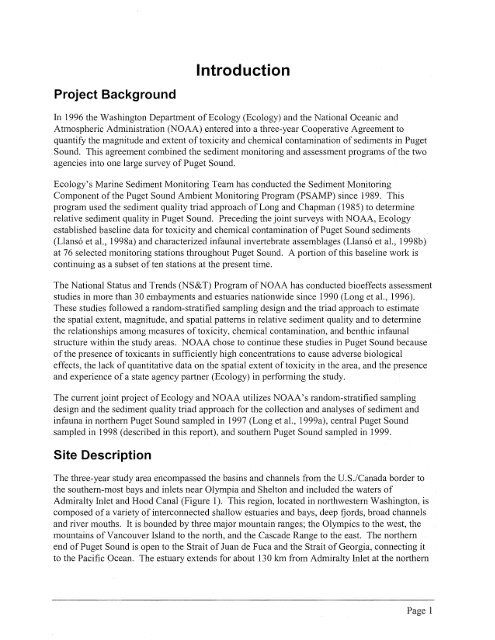Sediment Quality in Puget Sound Year 2 - Center for Coastal ...
Sediment Quality in Puget Sound Year 2 - Center for Coastal ...
Sediment Quality in Puget Sound Year 2 - Center for Coastal ...
Create successful ePaper yourself
Turn your PDF publications into a flip-book with our unique Google optimized e-Paper software.
Project Background<br />
Introduction<br />
hi 1996 the Wash<strong>in</strong>gton Department of Ecology (Ecology) and the National Oceanic and<br />
Atmospheric Adm<strong>in</strong>istration (NOAA) entered <strong>in</strong>to a three-year Cooperative Agreement to<br />
quantify the magnitude and extent of toxicity and chemical contam<strong>in</strong>ation of sediments <strong>in</strong> <strong>Puget</strong><br />
<strong>Sound</strong>. This agreement comb<strong>in</strong>ed the sediment monitor<strong>in</strong>g and assessment programs of the two<br />
agencies <strong>in</strong>to one large survey of <strong>Puget</strong> <strong>Sound</strong>.<br />
Ecology's Mar<strong>in</strong>e <strong>Sediment</strong> Monitor<strong>in</strong>g Team has conducted the <strong>Sediment</strong> Monitor<strong>in</strong>g<br />
Component of the <strong>Puget</strong> <strong>Sound</strong> Ambient Monitor<strong>in</strong>g Program (PSAMP) s<strong>in</strong>ce 1989. This<br />
program used the sediment quality triad approach of Long and Chapman (1985) to determ<strong>in</strong>e<br />
relative sediment quality <strong>in</strong> <strong>Puget</strong> <strong>Sound</strong>. Preced<strong>in</strong>g the jo<strong>in</strong>t surveys with NOAA, Ecology<br />
established basel<strong>in</strong>e data <strong>for</strong> toxicity and chemical contam<strong>in</strong>ation of <strong>Puget</strong> <strong>Sound</strong> sediments<br />
(Llanso et al., 1998a) and characterized <strong>in</strong>faunal <strong>in</strong>vertebrate assemblages (Llanso et al., 1998b)<br />
at 76 selected monitor<strong>in</strong>g stations throughout <strong>Puget</strong> <strong>Sound</strong>. A portion of this basel<strong>in</strong>e work is<br />
cont<strong>in</strong>u<strong>in</strong>g as a subset of ten stations at the present time.<br />
The National Status and Trends (NS&T) Program of NOAA has conducted bioeffects assessment<br />
studies <strong>in</strong> more than 30 e'mbayments and estuaries nationwide s<strong>in</strong>ce 1990 (Long et al., 1996).<br />
These studies followed a random-stratified sampl<strong>in</strong>g design and the triad approach to estimate<br />
the spatial extent, magnitude, and spatial patterns <strong>in</strong> relative sediment quality and to determ<strong>in</strong>e<br />
the relationships among measures of toxicity, chemical contam<strong>in</strong>ation, and benthic <strong>in</strong>faunal<br />
structure with<strong>in</strong> the study areas. NOAA chose to cont<strong>in</strong>ue these studies <strong>in</strong> <strong>Puget</strong> <strong>Sound</strong> because<br />
of the presence of toxicants <strong>in</strong> sufficiently high concentrations to cause adverse biological<br />
effects, the lack of quantitative data on the spatial extent of toxicity <strong>in</strong> the area, and the presence<br />
and experience of a state agency partner (Ecology) <strong>in</strong> per<strong>for</strong>m<strong>in</strong>g the study.<br />
The current jo<strong>in</strong>t project of Ecology and NOAA utilizes NOAA's random-stratified sampl<strong>in</strong>g<br />
design and the sediment quality triad approach <strong>for</strong> the collection and analyses of sediment and<br />
<strong>in</strong>fauna <strong>in</strong> northern <strong>Puget</strong> <strong>Sound</strong> sampled <strong>in</strong> 1997 (Long et al., 1999a), central <strong>Puget</strong> <strong>Sound</strong><br />
sampled <strong>in</strong> 1998 (described <strong>in</strong> this report), and southern <strong>Puget</strong> <strong>Sound</strong> sampled <strong>in</strong> 1999.<br />
Site Description<br />
The three-year study area encompassed the bas<strong>in</strong>s and channels from the U.S./Canada border to<br />
the southern-most bays and <strong>in</strong>lets near Olympia and Shelton and <strong>in</strong>cluded the waters of<br />
Admiralty Inlet and Hood Canal (Figure 1). This region, located <strong>in</strong> northwestern Wash<strong>in</strong>gton, is<br />
composed of a variety of <strong>in</strong>terconnected shallow estuaries and bays, deep fjords, broad channels<br />
and river mouths. It is bounded by three major mounta<strong>in</strong> ranges; the Olympics to the west, the<br />
mounta<strong>in</strong>s of Vancouver Island to the north, and the Cascade Range to the east. The northern<br />
end of <strong>Puget</strong> <strong>Sound</strong> is open to the Strait of Juan de Fuca and the Strait of Georgia, connect<strong>in</strong>g it<br />
to the Pacific Ocean. The estuary extends <strong>for</strong> about 130 krn from Admiralty Inlet at the northern<br />
Page 1







